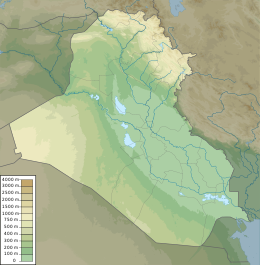
Back Kassiete Afrikaans ካሣውያን Amharic كيشيون Arabic Kassitlər Azerbaijani کاسسیتلر AZB Касіты Byelorussian Касити Bulgarian Cassites Catalan Mga Kasita CEB کاسییەکان CKB
Map of Iraq showing important sites that were occupied by the Kassite dynasty of Babylonia (clickable map) | |
| Regions with significant populations | |
|---|---|
| Karduniash | |
| Languages | |
| Kassite | |
| Religion | |
| Kassite religion, later subsumed into Mesopotamian religion |
The Kassites (/ˈkæsaɪts/) were people of the ancient Near East, who controlled Babylonia after the fall of the Old Babylonian Empire c. 1531 BC and until c. 1155 BC (short chronology).
They gained control of Babylonia after the Hittite sack of Babylon in 1531 BC, and established a dynasty generally assumed to have been based first in that city, after a hiatus. Later rule shifted to the new city of Dur-Kurigalzu.[1] By the time of Babylon's fall, the Kassites had already been part of the region for a century and a half, acting sometimes with Babylon's interests and sometimes against.[2] There are records of Kassite and Babylonian interactions, in the context of military employment, during the reigns of Babylonian kings Samsu-iluna (1686 to 1648 BC), Abī-ešuh, and Ammī-ditāna.[3]
The origin and classification of the Kassite language, like the Sumerian language and Hurrian language, is uncertain, and, also like the two latter languages, has generated a wide array of speculation over the years, even to the point of linking it to Sanskrit, however like these other languages it is regarded as a Language Isolate and is not accepted to be Semitic or Indo-European.[4] The Kassite religion is also poorly known. The names of some Kassite deities are known.[5] The chief gods, titular gods of the kings, were Shuqamuna and Shumaliya which are distinct from Sumerian, Semitic and Indo-European gods.[6] As was typical in the region, there was some cross pollination with other religions. After Babylon came within the Kassite sphere of control its city-god, Marduk was absorbed into the Kassite pantheon.[7]
- ^ Brinkman, J. A.. "1. Babylonia under the Kassites: Some Aspects for Consideration". Volume 1 Karduniaš. Babylonia under the Kassites 1, edited by Alexa Bartelmus and Katja Sternitzke, Berlin, Boston: De Gruyter, 2017, pp. 1-44
- ^ van Koppen, Frans. “THE OLD TO MIDDLE BABYLONIAN TRANSITION: HISTORY AND CHRONOLOGY OF THE MESOPOTAMIAN DARK AGE.” Ägypten Und Levante / Egypt and the Levant, vol. 20, 2010, pp. 453–63
- ^ Koppen, Frans van. "2. The Early Kassite Period". Volume 1 Karduniaš. Babylonia under the Kassites 1, edited by Alexa Bartelmus and Katja Sternitzke, Berlin, Boston: De Gruyter, 2017, pp. 45-92
- ^ Pinches, T. G. “The Question of the Kassite Language.” Journal of the Royal Asiatic Society of Great Britain and Ireland, 1907, pp. 685–685
- ^ Malko, Helen. "The Kassites of Babylonia: A Re-examination of an Ethnic Identity". Babylonia under the Sealand and Kassite Dynasties, edited by Susanne Paulus and Tim Clayden, Berlin, Boston: De Gruyter, 2020, pp. 177-189
- ^ Krebernik, M., and Seidl, U. (2012). "Šuqamuna und Šu/imalija." [in:] Reallexikon der Assyriologie und vorderasiatischen Archäologie vol 13, p. 323-325
- ^ Tenney, J. S. (2016). The elevation of Marduk revisited: Festivals and sacrifices at Nippur during the High Kassite period. Journal of Cuneiform Studies, 68(1), 153-180. Pg 154 note 4.
